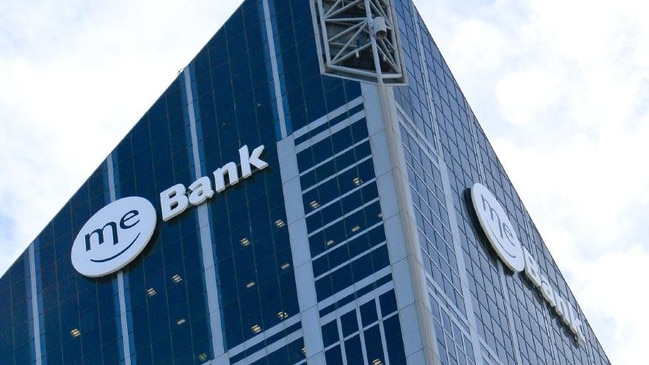
This column understands resistance from ME’s shareholders for an exit has largely abated and a sale is a live option.
Bank of Queensland and Bendigo and Adelaide Bank are keeping close tabs on the ME situation, and are also involved in separate talks, alongside Macquarie Group, with AMP suitor Ares to participate in a joint $6bn bid for the entire wealth group.
The Australian revealed those AMP bid discussions on January 6. An AMP joint bid would see one of the aforementioned players buy AMP bank as part of a whole-of-company transaction led by US group Ares.
ME — owned by 26 of Australia’s industry super funds — represents an attractive proposition for BoQ at the right price, given it is predominantly a home lender. BoQ’s largest division is its business bank, and it would welcome scale in mortgages.
Suncorp’s bank is the other asset that is commonly linked to consolidation activity, but despite the expectations it’s been a quiet few years.
Over the past 15 years, on-again, off-again discussions have taken place for a merger of BoQ and Bendigo and Adelaide Bank, and at one stage the talks included a potential three-way tie-up with Suncorp’s bank.
About six years ago, BoQ and Suncorp discussed a merger, while a takeover of Bendigo Bank by BoQ was pondered in 2007 but vetoed by the former‘s board. Bendigo instead struck a deal to acquire Adelaide Bank in the same year.
Bank takeovers and mergers are always accompanied by a long list of integration challenges, but scale and synergies are also important at a time of a low earnings growth. That may be enough to spur more rationalisation in coming months.
Branch axe
Cost-cutting is certainly on the agenda of the big banks this year, as is ensuring digital engagement with customers is up to scratch.
Commonwealth Bank on Thursday gave an update on its plans to ramp up tech investment to more than $6bn over five years, compared to a prior target of $5bn.
But in an interesting twist, reported first by Sky News, CBA boss Matt Comyn also let slip that the big banks were jointly mulling a way to merge branch networks as they look at ways to reduce their physical presence.
“It’s something the industry has contemplated. One of the limitations tends to be the tech across different banking institutions is quite different — the integration and the cost to make that a proposition that could work for a customer from any bank coming into a single place … but clearly there are fewer people going into branches than there were a year ago,” Comyn said.
“COVID certainly accelerated that, so we’ve just got to get that balance right — keep providing that convenient service, particularly in regional areas which is always a key focus area, and the industry within relevant competition grounds should look for ways to make sure we’re providing the best overall service experience.”
Branches and ATMs are squarely on the chopping block for the big banks, but Comyn’s words underscore the continued political sensitivity around points of presence. The banks will want to manage this carefully, given they have so far come through COVID-19 with their reputations in reasonable shape, given the battering they took in 2018 and 2019 as the royal commission played out.
CBA’s plans to step up its technology spend come as ANZ puts the finishing touches on secretive plans to roll out a new digital banking platform in the second quarter of 2021.
Westpac is using its investment in Antony Jenkins’s cloud-based 10x Future Technologies to boost its digital presence and customer engagement, while NAB is also pushing into the cloud and using digital arm UBank as a key challenger brand.
Macquarie briefing
Macquarie Group’s annual operational briefing is less than two weeks away and will be headlined by chief Shemara Wikramanayake.
She’ll provide an update on the outlook leading into the end of Macquarie’s balance date on March 31, flanked by several key lieutenants.
The line-up includes Macquarie asset management boss Martin Stanley, co-heads of the capital division Daniel Wong and Michael Silverton, and corporate operations group chief Nicole Sorbara.
Analysts are closely watching a number of earnings levers and external factors in the lead-up to Macquarie’s briefing.
The Australian dollar has rallied about 8.5 per cent in the past three months, which doesn’t bode well for Macquarie, which earns about 68 per cent of its income offshore.
But the group will be banking bumper proceeds from its selldown in now ASX-listed software group Nuix, and probably profits or performance fees from other divestments, which will boost the bottom line.
Another divestment includes the sale of 39 Martin Place in Sydney to a joint venture between Investa Commercial Property Fund and Manulife Financial Corporation, which Macquarie is developing as part of the new metro precinct.
Macquarie’s infrastructure funds have agreed to divest a string of assets in the past three months, including a 69.4 per cent interest in gas transmission operator Societa Gasdotti Italia to Ontario Teachers’ Pension Plan Board.
Analysts are tipping Macquarie will report a full-year profit of $2.19bn, down from $2.73bn.




The prospect of a fresh round of rationalisation among second-tier banks is very real in 2021, with AMP’s bank and industry fund-backed ME in the crosshairs of potential buyers.